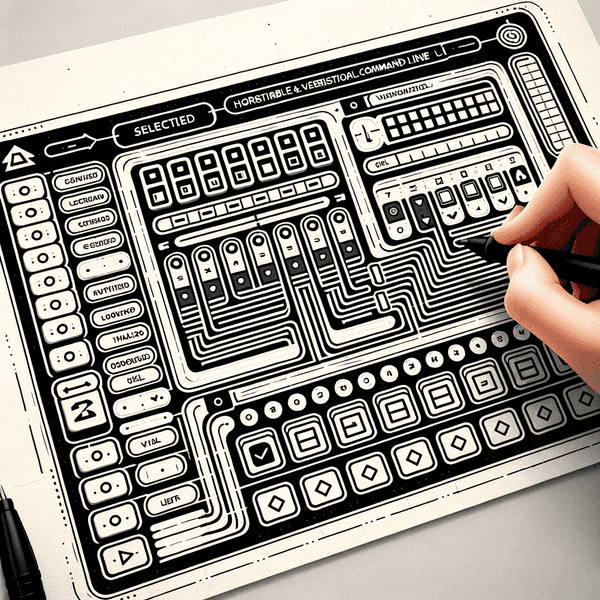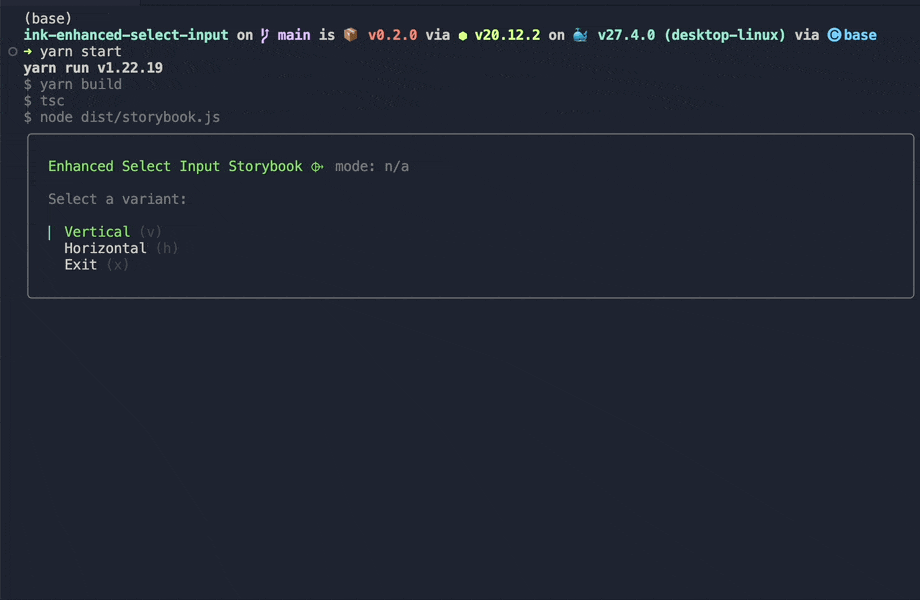Ink Enhanced Select Input: A Flexible Horizontal & Vertical Select Component for the Terminal
December 22, 2024


When building command-line interfaces (CLIs) with React and Ink, one of the key elements is often a menu or select component. While Ink’s ecosystem provides some great out-of-the-box components like ink-select-input, there’s an outstanding feature that I found lacking: true support for a horizontal orientation. For games and other visually complex terminal applications, a horizontal list of options can save valuable vertical space and create a more natural user experience.
The Need for a Horizontal Select Input
During the development of my text-based RPG, Potion Wars, screen real estate became a primary concern. The game relies heavily on menus and selectors for user input, but vertical lists quickly consume too many lines. By adopting a horizontal layout, I could place menus side-by-side, conserving vertical space and giving the UI more breathing room.
I dug into the existing solutions and discovered an older issue in the ink-select-input repository calling for horizontal orientation support. Another developer, H3RSKO, created a fork called ink-select-input-horizontal, but my testing revealed limitations and a few lingering bugs that made it less than ideal for my needs.
Introducing Ink Enhanced Select Input
To address these issues, I decided to build my own component: ink-enhanced-select-input. This component extends the original idea of ink-select-input but adds native support for an orientation prop. With this prop, you can easily switch between a vertical list (the classic style) and a horizontal layout, opening the door to more creative CLI interfaces.
In addition, I’ve added various features and properties over time, as required by Potion Wars’ evolving mechanics:
- Orientation Prop: Choose between
verticalorhorizontalfor your layout. - Custom Indicators & Items: Easily supply your own components, from fancy glyphs to color-coded labels.
- Hotkey Support: Assign single-character hotkeys for lightning-fast selection.
- Disabled Items: Exclude certain options from being selected without removing them entirely.
- Limit Displayed Items: Show only a subset of choices at a time, useful for large lists.
- Callbacks for onHighlight & onSelect: Hook into state changes to run custom logic.
By developing this component alongside my game, I was able to battle-test it in a real environment, ensuring that it not only worked as expected, but also felt intuitive and stable.
Component Showcase
Below are a number of gifs that demonstrate the ink-enhanced-select-input in action within the tBlackjack game.
Default Vertical & Horizontal Modes


Custom Indicators


Current State & Roadmap
Ink Enhanced Select Input is now published on NPM and available for anyone to integrate into their Ink-based CLIs. It works well, but I’m not stopping there. Here are a few things I’d love to explore in the future:
- Scrolling / Pagination Support: For large item sets, provide a built-in way to paginate or scroll through items.
- Dynamic Item Updates: Make it easier to update the list as users perform actions, without losing state or focus.
- Search / Filtering Integration: Allow users to quickly find the right option via an integrated search field or type-ahead filtering.
- Extensive Theming Options: More hooks for styling, colors, and layouts, making it easier to adapt to various branding or thematic styles.
- Accessibility Enhancements: Consider improvements in how the component communicates its state and controls for users relying on assistive technologies.
Feedback & Contributions Welcome
This project was born from the challenges I encountered and the feedback I received regarding existing solutions. Now that it’s open-source, I’m eager to hear from other developers utilizing Ink!
You can find the repository here on GitHub. Feel free to open issues, suggest enhancements, or submit pull requests!

Published on
December 22, 2024

